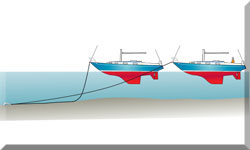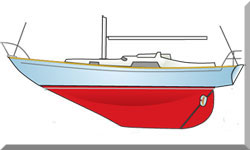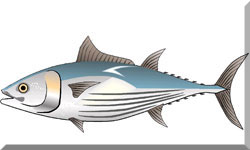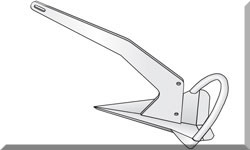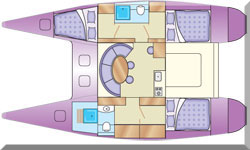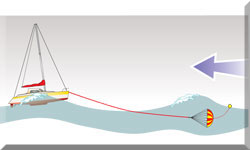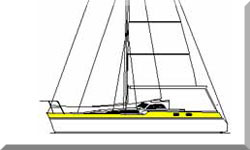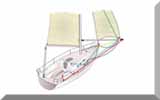- Home
- Bluewater Sailing
- Sailboat Flag Etiquette
Sailboat Flag Etiquette: A Definitive Guide to International & Courtesy Flags
In a Nutshell...
Sailboat Flag Etiquette is a time-honoured set of traditions and maritime laws that dictate how we show respect on the water. As an experienced sailor, you should know that the Ensign (which identifies your vessel's nationality) holds the highest importance; it's worn at the stern or gaff. The Courtesy Flag (of a host nation) is a mandatory sign of respect, flown high on the starboard spreader, while the Burgee (your yacht club affiliation) usually goes at the main masthead. Getting the size, position, and timing right isn't just about good manners—it’s often a legal requirement under international maritime law.
 A Canadian Ensign proudly worn on this Newport 41
A Canadian Ensign proudly worn on this Newport 41Table of Contents
- Sizing, Position & Seniority
- When to Fly & Strike Your Colours
- Advanced Protocol: The Jack, Officers & Pilots
- Regional Compliance: A Flag Position Comparison
- Legal & Regulatory Considerations
- Modern Adaptations & Regional Variations
- Dressing Ship & Special Occasions
- Flag Maintenance & Replacement
- Summing Up
- Frequently Asked Questions (FAQs)
When you’re out on the water, the flags you fly aren't just bits of coloured cloth; they are your boat’s voice. They speak volumes about your vessel’s nationality, your affiliations, and—crucially—your respect for maritime law and tradition. For those of us who spend serious time offshore, understanding sailboat flag etiquette isn't merely a quaint pastime; it's a fundamental part of good seamanship and a nod to the centuries of tradition that bind the sailing community.
You see all sorts of variations out there, and frankly, a lot of them are wrong. Knowing the rules ensures you uphold the proper protocol respected by seafarers the world over and, just as importantly, keeps you on the right side of international regulations.
Oh yes, and while I remember:
- A vessel wears an ensign, but
- A vessel flies a flag.
Historical Context & Tradition
Maritime flag etiquette has deep roots. For centuries, flags served as essential signals in naval battles, daily communication at sea, and territorial claims. Early seafarers used banners and pennants to indicate alliances, identify vessels, and sometimes to intimidate adversaries.
Today’s national ensigns, such as the iconic Red Ensign for UK-registered boats, carry forward these ancient traditions. These historical signals remind us that every detail—from the flag’s design to its precise placement—has a story behind it, reflecting centuries of maritime heritage and respect for the craft of sailing. It’s a tradition we’re proud to uphold, especially after a long passage.
Understanding the Key Players: The Types of Flags
You might fly many flags, but a few are mandatory or universally expected when cruising internationally.
| Flag Type | Purpose & Significance | Standard Position |
|---|---|---|
| The Ensign | Indicates the vessel's country of registry & nationality. The most senior flag. | Stern staff (taffrail) or gaff. |
| The Burgee | Shows affiliation with a yacht club or association. | Main masthead (pigstick) or port spreader. |
| The Courtesy Flag | The national flag of the country you are visiting. A sign of respect & goodwill. | Starboard spreader (highest position). |
| The Q Flag | Signals a request for Quarantine or customs/health clearance upon arrival. | Starboard spreader, below the Courtesy Flag (if one is flying). |
| Signal Flags | Used to convey specific messages using the International Code of Signals. | Various locations, depending on the signal. |
| The Private Signal | A personal or family emblem; purely optional & decorative. | Port spreader (below any burgee). |
Sizing, Position & Seniority
Getting the size and placement right is important for both aesthetic and practical reasons. Flags should be proportionate to your boat size, visible from a distance, and clear of any obstruction. The general rules for sizing and positioning flags are straightforward:
The Ensign: This flag takes seniority over all others.
- Sizing: A good rule of thumb is one inch on the fly (the length) for every foot of your boat’s overall length. For a 40-foot yacht, you're looking for a 40-inch fly.
- Position: It’s worn from the stern staff (taffrail) or, on a ketch or yawl, from the gaff or the mizzen mast. I find the stern staff placement the most common and practical on a cruising yacht without a gaff, which of course is the vast majority of us.
The Burgee:
- Sizing: Aim for about half an inch on the fly for every foot of overall length of your sailboat.
- Position: Traditionally, it's at the main masthead. If that spot is cluttered with a VHF antenna or other gear, it’s often flown from the port spreader.
The Courtesy Flag & Q Flag:
- Sizing: These should be the same size as your Burgee or slightly smaller. They must never be larger than your own Ensign.
- Position: Flown from the starboard spreader, as this is the position of honour for flags representing the host country.
When to Fly & Strike Your Colours
The Protocol for Hoisting & Lowering
The general rules for flying flags are covered by what we call "hoisting colours" and "striking colours."
- Mandatory Ensign: You must wear your Ensign at all times during daylight hours, especially when you are near to or in sight of land or another boat. It's absolutely mandatory when entering or leaving a foreign port. While you can leave your Ensign up at night, it’s not required.
- Club Burgee: Custom dictates you hoist this flag smartly at 0800 hours and lower it at sunset.
- Courtesy & Q Flags: You must hoist the Courtesy Flag of the country you’re visiting as soon as you enter their jurisdiction and keep it up until you depart. The Q flag goes up when you arrive in a foreign port, and stays there until you’ve been formally cleared by local authorities. Once cleared, the Q flag comes down, but the Courtesy Flag stays up.
The Lost Art of the Ensign Salute & Dipping
This specific protocol often separates the seasoned sailor from the novice, and it’s a critical piece of sailboat flag etiquette.
- The Salute: When your yacht passes a warship or another vessel of a different nationality close by, it’s customary to salute them by 'dipping' the Ensign.
- The Dipping Procedure: The flag is briskly lowered from its full position to one-third of the way up the staff or halyard (it’s never fully lowered). The warship or vessel will then return the compliment by dipping its own flag. Once the salute has been returned, you must immediately re-hoist your Ensign to the peak.
- Handling Protocol: A critical rule to remember: the Ensign, or any national flag, should never be allowed to touch the water or the deck. Care must be taken during hoisting and lowering to ensure this. This demonstrates profound respect for the national emblem.
Advanced Protocol: The Jack, Officers & Pilots
To round out your knowledge of sailboat flag etiquette, especially when cruising in unfamiliar or controlled waters or when hosting club officials, you should know about these specific flags.
The Jack: A Distinction from the Ensign
The Jack is a small flag that’s flown from the Jackstaff at the bow (the very front) of the vessel.
- UK Protocol: For UK-registered vessels, the correct Jack is a miniature Union Flag (Union Jack).
- When to Fly It: It is only flown when the vessel is dressed overall for a special occasion, when at anchor, or when moored in a home port—and critically, only during the same hours the Ensign is worn (0800 to sunset). It must never be flown while under way.
Flag Officers' Flags & Broad Pennants
If you or a guest are an official of a recognised yacht club, the burgee is replaced by a specific flag denoting rank.
- Broad Pennants: Commodores, Vice Commodores, and Rear Commodores fly a swallow-tailed flag (a Broad Pennant) instead of the club burgee. This flag takes the same position as the Burgee—traditionally the main masthead.
- Owner’s Absentee Flag: Some traditional clubs permit the use of a small blue or white flag flown at the starboard spreader when the owner is absent but the vessel is being used by a member or crew.
The Pilot Flag (International Code Flag G)
When approaching a port that requires a pilot (a local expert to navigate difficult waters), you must signal your need clearly.
- Function: The International Code Flag G (Golf), often called the Pilot Flag, is flown to signal, "I require a pilot."
- Position: It’s traditionally flown from the main masthead (or port spreader if the burgee is at the masthead). Once the pilot is aboard, the Pilot Flag is generally lowered.
Regional Compliance: A Flag Position Comparison
When cruising internationally, the differences in acceptable sailboat flag etiquette can be confusing. This table helps clarify the position of flags based on common cruising jurisdictions.
| Flag | UK / Commonwealth (Traditional) | USA (Yacht Ensign/50-Star Flag) | Continental Europe (General) |
|---|---|---|---|
| Vessel's Ensign | Stern staff or gaff (most senior). | Stern staff or gaff (most senior). | Stern staff or gaff (most senior). |
| Burgee | Main masthead (preferred) or port spreader. | Masthead or bow staff (powerboats) or starboard spreader. | Main masthead or port spreader. |
| Courtesy Flag | Starboard spreader (highest position). | Starboard spreader (highest position). | Starboard spreader (highest position). |
| Jack (Bow) | Union Flag (only when moored/at anchor). | 50-Star Flag (only on Navy/Govt vessels). | Generally not flown by private yachts. |
Legal & Regulatory Considerations
Beyond tradition, there are firm regulations that govern the display of flags. Improper usage—such as flying a damaged Ensign or using a special ensign without entitlement—can lead not only to breaches of etiquette but also to fines or legal action under relevant maritime acts, such as the UK’s Merchant Shipping Act.
Understanding and complying with these regulations protects you from potential penalties while upholding the protocols respected by seafarers around the world.
Privileged & Defaced Ensigns
While the Red Ensign is the standard national flag for British private yachts, certain yacht clubs hold a warrant from the Secretary of State for Defence, granting their members the privilege of wearing a Special Ensign. These are often referred to as Privileged Ensigns.
These flags typically fall into three categories:
1. The White Ensign: Exclusively reserved for the Royal Navy and members of the Royal Yacht Squadron (RYS).
2. The Plain Blue Ensign: Reserved for members of a select few, very senior yacht clubs.
3. The Defaced Blue or Red Ensign: This is the most common form of special ensign, which features the club’s specific badge (the "deface") placed within the flag.
Crucial Rules for Special Ensigns:
- Permit Required: You must hold a valid, in-date permit issued by your club for your specific vessel, and this permit must always be carried on board.
- Registration & Size: The yacht must meet minimum size requirements (currently 7m LOA) and be properly registered.
- Owner On Board: The Special Ensign may only be worn when the owner (or the holder of the permit) is personally on board and in command.
- The Burgee Rule: The corresponding club Burgee must always be flown with the Special Ensign. It is usually hoisted before the ensign and lowered after it. Failure to fly the burgee invalidates the use of the ensign.
- Non-Commercial Use: The vessel must be used exclusively for private, non-commercial purposes.
Wearing a Special Ensign without meeting every one of these strict conditions is a breach of the Merchant Shipping Act 1995 and can result in significant penalties.
Immediate Troubleshooting: Flags as Distress Signals
When communications fail or visibility is low, flags become a life-saving tool. There are three critical, internationally recognised visual distress signals using flags or flag-like items that every competent sailor should memorise:
- Code Flag NC: Hoisted together, the flags N (November, square blue/white) and C (Charlie, striped blue/white/red) together mean "I am in distress and require immediate assistance."
- Square Flag over Ball: Hoisting a square flag (any non-national flag, like a house flag) directly over a ball or anything round (such as an inflatable fender) is an internationally recognised distress signal.
- Upside Down Ensign: While highly dramatic and generally reserved for dire situations, hoisting your national Ensign upside down is an internationally recognised signal of extreme or unusual distress.
Common Mistakes & Pitfalls to Avoid
Flying flags can be tricky. Steering clear of these common blunders will save you embarrassment and potential trouble:
- Flying an Invalid Ensign: Never wear a faded, torn, or otherwise damaged Ensign. This is a sign of extreme disrespect. Replace it immediately.
- Incorrect Size & Seniority: Never fly a Courtesy Flag that is larger than your Ensign.
- Ignoring the Q Flag: Failing to fly the Q Flag (Quarantine) when entering a foreign port is a serious breach of health and customs regulations and can cause significant delays or fines.
- The Skull & Crossbones: And you should never, ever, fly a skull-and-crossbones flag. There is nothing amusing or glamorous about pirates; it’s juvenile and disrespectful.
Modern Adaptations & Regional Variations
While traditions run deep, modern maritime practices have introduced useful adaptations. For instance, technological advancements like GPS and AIS have refined navigational processes, sometimes reducing dependency on complex visual signal flags. In racing or commercial scenarios, flag placements might adapt to suit new technology or design considerations.
Furthermore, regional differences in flag protocols can be significant. What works perfectly in the United Kingdom might differ from practices in the United States or other maritime nations. Awareness of these nuances is critical, especially for those navigating international waters, ensuring respectful and legally compliant displays wherever you sail. Always check the specific flag requirements for the country you plan to visit, as their local customs (like when to strike the Ensign) may vary slightly.
Dressing Ship & Special Occasions
Flag etiquette takes on unique meanings during special events, too. Whether you’re participating in a regatta, commemorating a historic event, or holding a memorial service, the way you display your flags conveys deep respect and unity.
- Dressing Ship: This is a festive arrangement, usually reserved for national holidays, special regattas, or visits by dignitaries. It involves stringing all available signal flags from the water line at the bow, over the masthead, and down to the water line at the stern in a specific, approved order, creating a colourful arc. Note: The national Ensign must be worn in its proper position at the stern.
- Half-Mast: Flying a flag at half-mast is a time-honoured tribute at funerals or memorials. The flag should first be hoisted briskly to the peak, and then slowly lowered to the half-mast position. When striking the flag, it should be slowly hoisted back to the peak, and then smartly lowered for striking.
Flag Maintenance & Replacement
Maintaining your collection of flags is essential to preserve their symbolic integrity. Exposure to harsh weather can cause deterioration, fading, or wear that not only diminishes the aesthetics but might also render them legally noncompliant.
You can't afford a flimsy Courtesy Flag that disintegrates halfway across the Bay of Biscay. Establishing a regular maintenance and replacement schedule—be it monthly, quarterly, or seasonally—will ensure your flags remain crisp and vibrant. Keeping spare flags on board and routinely inspecting them can prevent accidental breaches and uphold the proud traditions they embody.
Summing Up
Mastering Sailboat Flag Etiquette is a mark of a competent and respectful sailor. It is a language spoken between vessels across oceans, and adhering to its protocol is a sign of good seamanship and respect for the countries you visit. Get the size and position of your Ensign right, always fly the appropriate Courtesy Flag in foreign waters, and be meticulous with the timing of hoisting and striking colours. By knowing not only the basics but also the finer points, such as the use of the Jack and Officer's Pennants, you demonstrate the level of professionalism that every serious blue-water mariner should possess.
Ultimately, mastering these traditions is part of the broader preparation for life at sea; if you’re looking to master all aspects of ocean sailing, we suggest you check out our comprehensive guide Preparation & Seamanship for the Ocean.
This article was written by Dick McClary, RYA Yachtmaster and author of the RYA publications 'Offshore Sailing' and 'Fishing Afloat', member of The Yachting Journalists Association (YJA), and erstwhile member of the Ocean Cruising Club (OCC).
Frequently Asked Questions (FAQs)
How large should my Ensign be?
How large should my Ensign be?
The Ensign should be approximately one inch on the fly (length) for every foot of your boat’s overall length. This ensures it is proportionate and clearly visible, a key factor in proper sailboat flag etiquette.
Where should the Yacht Club Burgee be flown?
Where should the Yacht Club Burgee be flown?
The Burgee is traditionally flown at the main masthead (or a pigstick extension). If this is impractical (due to antennas, etc.), it is flown from the port spreader.
Is it mandatory to fly a Courtesy Flag in a foreign country?
Is it mandatory to fly a Courtesy Flag in a foreign country?
Yes, absolutely. Flying the Courtesy Flag of the host nation from the starboard spreader is a mandatory international protocol and a sign of respect for their waters and sovereignty. Failure to do so can sometimes lead to issues with local authorities.
When should I fly and strike my boat's flags?
When should I fly and strike my boat's flags?
The general rule is that flags should be hoisted smartly at 0800 hours and lowered at sunset. The Ensign, however, must be flown at all times in daylight when entering or leaving a port, or when in sight of land or another vessel.
What is the purpose of the Q Flag in flag etiquette?
What is the purpose of the Q Flag in flag etiquette?
The Q Flag (International Code Flag Quebec) is a yellow flag flown upon entering foreign waters to signal to the authorities that the vessel is requesting clearance from customs, health, and immigration officers. It should be flown until official clearance has been granted.
What is the correct way to salute another vessel with my Ensign?
What is the correct way to salute another vessel with my Ensign?
To salute, you 'dip' the Ensign by lowering it briskly to one-third of the way down the halyard or staff. After the other vessel (usually a warship) returns the salute by dipping their flag, you must immediately re-hoist your Ensign to the peak.
When is it appropriate to fly the Jack (Union Flag)?
When is it appropriate to fly the Jack (Union Flag)?
The Jack is flown at the bow (jackstaff) and is only worn when the vessel is moored or at anchor in a home port, or when dressed overall for a special occasion. Crucially, it must only be flown during 'Ensign hours' (0800 to sunset) and never while the vessel is under way.
Recent Articles
-
Optimising Your 12-Volt Boat Fridge for Offshore Sailing & Efficiency
Dec 01, 25 11:05 AM
Master your 12-Volt Boat Fridge system. A guide for experienced sailors covering mechanics, installation, troubleshooting, and advanced electrical efficiency on extended voyages. -
Jonmeri 40: Cruising Specs, Performance Ratios & Review
Nov 30, 25 09:08 AM
An in-depth, expert review of the Jonmeri 40 sailboat. Analyse design philosophy, D/L & CSF ratios, cruising suitability, and common ownership concerns for this Finnish-built, high-performance ocean c… -
Alajuela 48: Review, Specs, & Performance Ratios for Offshore Cruisers
Nov 29, 25 12:46 PM
Detailed analysis of the Alajuela 48 full-keel cruiser, including designer Robert Perry's philosophy, comprehensive specifications, key design ratios (SA/D, D/L, CSF), and suitability for experienced…

